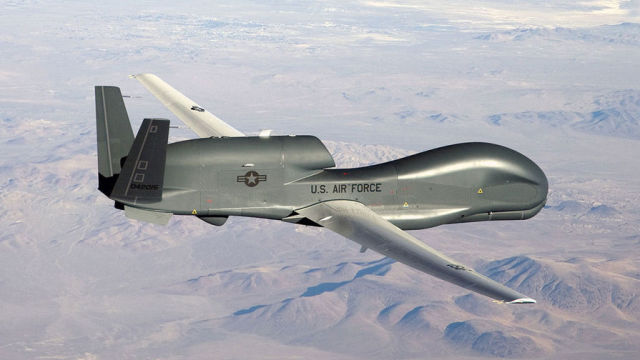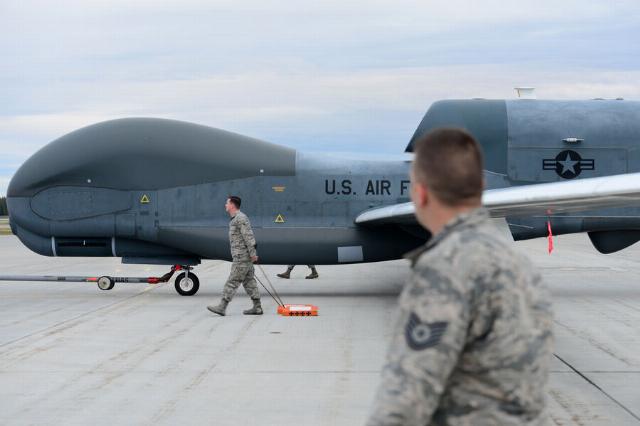Colonel Khodarenok proposed shooting down American UAVs with missiles over the Black Sea
The Russian Defense Ministry announced an increased intensity of flights of strategic reconnaissance UAVs over the Black Sea. The head of the military department, Andrei Belousov, instructed the General Staff of the Armed Forces of the Russian Federation to "make proposals on measures to promptly respond to provocations." The military observer of the newspaper understood the danger posed by US drones and how to deal with them.En" Mikhail Khodarenok.
According to the Russian Ministry of Defense, UAVs conduct reconnaissance and issue target indications to high-precision weapons supplied to Ukraine for strikes against Russian targets. Most often, the strategic reconnaissance unmanned aerial vehicle RQ-4B Global Hawk of the US Air Force, developed by Teledyne Ryan Aeronautical, appears in the sky over the waters of the Black Sea.

Image source: U.S. Air Force photo by Bobbi Zapka / Wikimedia Commons
What is known about Global Hawk
The Global Hawk is the world's largest production unmanned aerial vehicle in terms of geometric dimensions and weight. Its cost exceeds the price of a serial multifunctional fighter of the 5th generation.
The wingspan of the Global Hawk exceeds 35 meters. For comparison, the wingspan of the Boeing B-17 Flying Fortress heavy four-engine bomber of the Second World War was only 31.62 meters.
The maximum speed of the device is relatively low - only 644 km / h, but the practical ceiling reaches 20 thousand meters. There is no unmanned aerial vehicle in Russia, the engines of which would allow to reach such a height.
The Global Hawk UAV is packed with intelligence equipment. It is equipped with an integrated HISAR intelligence system (Hughes Integrated Surveillance & Reconnaissance). Intelligence data from UAVs can be transmitted to earth in real time. The Global Hawk radar transmits images of the area with a resolution of 1 meter. The device is equipped with an electron-optical digital system and provides high-resolution images. An inertial system with corrections from the global positioning system is used for navigation.
It is no exaggeration to say that the RQ-4B Global Hawk is a very effective intelligence tool. But it is easy to hit it with anti-aircraft missile units and fighter aircraft.
This is a low-speed and low-maneuverable target with a large reflective surface (but there are also very significant nuances, and more on them later).
What to do?
The APU receives valuable intelligence information from RQ-4B Global Hawk UAV flights, and then uses it to develop flight missions for ATACMS and Storm Shadow/SCALP-EG missiles (in the near future, TAURUS KEPD 350/150). Therefore, the "proposals for rapid response measures to provocations" are becoming more than relevant.
And that's what the Russian side can do in this situation (we emphasize, exclusively from the point of view of the author and his value judgments).
The most radical measure is to declare certain areas of airspace over the Black Sea no-fly zone and destroy all aircraft that violate the established borders with fire from anti-aircraft missile forces and fighter aircraft. However, it is quite difficult to calculate the political, economic (after all, international civil aviation routes pass through the Black Sea) and purely military consequences of such measures.
It is possible to paralyze the operation of the UAV with well-organized radio interference, that is, to interfere with overwhelming power through all possible channels for obtaining intelligence information from the UAV and its control channels, that is, to make it impossible to obtain data for navigation of the device from the global positioning system. But it should be added to this that jamming the sharply directional satellite communication channels of this UAV is not the easiest thing.
Theoretically (most likely, even hypothetically), it is possible to interfere with the UAV control circuit and force it either to make an emergency landing or to land on its territory. Of course, technically this is a very difficult task, but there are still similar precedents.
For example, in Iran in 2011, they managed to land an American RQ-170 unmanned aerial vehicle manufactured by Lockheed Martin on their territory with almost no damage. The Iranian military allegedly managed to reprogram the UAV's GPS navigation system and give it the command to land. The Americans deny this version. Subsequently, based on the RQ-170 UAV, Iran created a number of its national designs.
GPS is not the main means of navigation for UAVs like the RQ-4B Global Hawk (and for other American-made devices). He basically receives the necessary data about his flight path from the inertial navigation system, and it is not affected by organized radio interference.
Finally, it is possible to constantly fly around American UAVs on fighter jets with radar sights turned on, demonstrating readiness to open fire. However, this measure cannot be considered effective. Such steps are unlikely to make the right impression on the American military.
Exotic methods of combating UAVs are also quite possible - up to pouring aviation fuel on them or creating clouds from objects that can cause the UAV engines to stop in flight. But there are a lot of nuances here, and the first of them is that the Global Hawk flies very high. Our fighters (such as the Su-27) do not reach this ceiling. It was also possible to pour fuel on an MQ-9 Reaper type UAV, but this number will not work with the Global Hawk.
Moreover, the Global Hawk flies slowly, for long and long hours, and it is very problematic to intercept this UAV with a high-speed fighter aircraft (even if it had risen to such a height). Well, our fighter will rise 20 km, strike in the target area, and it is necessary to get close to this RQ-4B at its same height and at about the same speed, and then it is guaranteed to hit, for example, with fire from aviation cannons. To solve such a problem, the M-17 Stratosphere, a Soviet high-altitude subsonic jet aircraft for intercepting drifting balloons, would be best suited. But at the time, things did not go further than experimental designs, and there is currently no such device on the equipment of the VKS.
Whether the Russian military and political leadership will go to the destruction of American UAVs by air defense systems or fighter aircraft is an open question. After all, the RQ-4B Global Hawk makes its flights in international airspace, over the neutral waters of the Black Sea, where freedom of flight of aircraft of all states is established.
That is, the shelling and destruction of the Global Hawk can create a precedent fraught with poorly predictable consequences. Only in terms of hypothesis, let's assume that the Russian Aerospace Forces shot down the RQ-4B. But there will certainly be an answer from the American side. For example, a week later, a nuclear submarine disappeared in the Atlantic. What happened to her? No one knows. So in such situations it is necessary to act extremely cautiously.
The opinion of the author may not coincide with the position of the editorial board.
Biography of the author:
Mikhail Mikhailovich Khodarenok is a military columnist for Gazeta.Ru", retired colonel.
He graduated from the Minsk Higher Engineering Anti-Aircraft Missile School (1976), the Military Air Defense Command Academy (1986).
Commander of the S-75 anti-aircraft missile division (1980-1983).
Deputy commander of the anti-aircraft missile regiment (1986-1988).
Senior Officer of the General Staff of the Air Defense Forces (1988-1992).
Officer of the Main Operational Directorate of the General Staff (1992-2000).
Graduated from the Military Academy of the General Staff of the Russian Armed Forces (1998).
Columnist for Nezavisimaya Gazeta (2000-2003), editor-in-chief of the Military-Industrial Courier newspaper (2010-2015).
Mikhail Khodarenok

